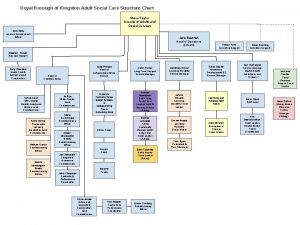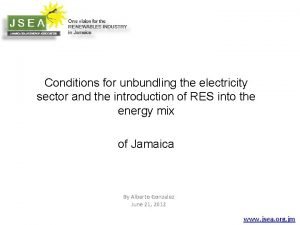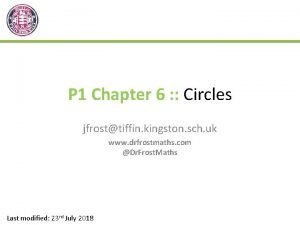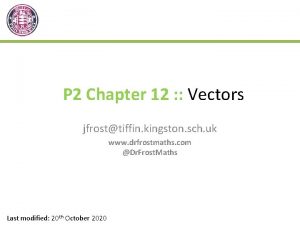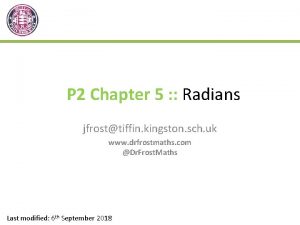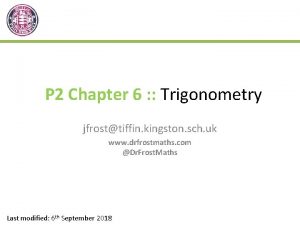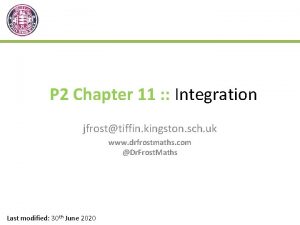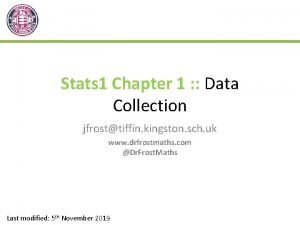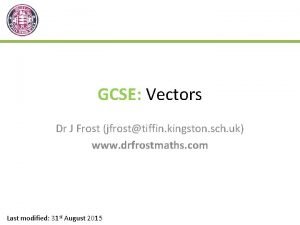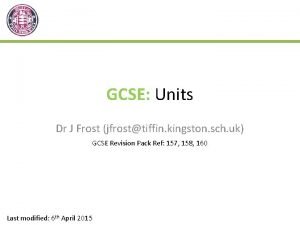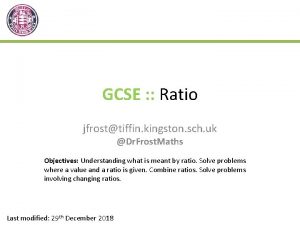Stats 1 Chapter 4 Correlation jfrosttiffin kingston sch













- Slides: 13

Stats 1 Chapter 4 : : Correlation jfrost@tiffin. kingston. sch. uk www. drfrostmaths. com @Dr. Frost. Maths Last modified: 3 rd March 2018

Use of Dr. Frost. Maths for practice Register for free at: www. drfrostmaths. com/homework Practise questions by chapter, including past paper Edexcel questions and extension questions (e. g. MAT). Teachers: you can create student accounts (or students can register themselves).

Experimental i. e. Dealing with collected data. Chp 1: Data Collection Methods of sampling, types of data, and populations vs samples. Chp 2: Measures of Location/Spread Chp 3: Representation of Data Statistics used to summarise data, including mean, standard deviation, quartiles, percentiles. Use of linear interpolation for estimating medians/quartiles. Producing and interpreting visual representations of data, including box plots and histograms. Chp 4: Correlation Measuring how related two variables are, and using linear regression to predict values. Theoretical Deal with probabilities and modelling to make inferences about what we ‘expect’ to see or make predictions, often using this to reason about/contrast with experimentally collected data. Chp 5: Probability Venn Diagrams, mutually exclusive + independent events, tree diagrams. Chp 6: Statistical Distributions Chp 7: Hypothesis Testing Common distributions used to easily find probabilities under certain modelling conditions, e. g. binomial distribution. Determining how likely observed data would have happened ‘by chance’, and making subsequent deductions.

This Chapter Overview Previously we have only considered one variable at a time. When we introduce a second variable (e. g. height with age), we might want to consider the relationship between them. This is a short chapter! “Describe the type of correlation. ” Hourly Pay (£) Hourly pay at 25 20 15 5 0 15 20 25 Age (years) Changes since the old ‘S 1’ syllabus: This chapter has been scaled back significantly since the S 1 ‘Correlation’ and ‘Regression’ chapters. You no longer need to determine the equation of the line of best fit (the regression line), or calculate measures of correlation, but merely have to interpret an equation already given or the limitations of estimates made or comment on the suitability of a linear regression model.

Recap of correlation Correlation gives the strength of the relationship (and the type of relationship) between two variables. Data with two variables is known as bivariate data. 100 Weekly time on internet (hours) Maths Score 80 70 60 Type of correlation: Weak ? positive ? correlation 50 40 30 20 10 strength 0 0 10 20 30 40 50 60 70 80 90 100 English Score type 20 15 10 0 £ 60. 00 £ 50. 00 Crime Rate £ 40. 00 £ 30. 00 £ 20. 00 Strong ? positive ? correlation £ 10. 00 £ 0. 00 0 50 100 Distance travelled (km) 5 0 £ 70. 00 Cost of train fare Weak ? negative ? correlation 25 90 150 20 40 Age 60 80 100 No ? correlation 40 35 30 25 20 15 10 5 0 0 10000 20000 30000 40000 50000 Number of people in city called 'Dave' 60000 The vertical-axis variable usually depends on the horizontal-axis value. For this reason distance would be the independent/explanatory variable and cost the dependent/response variable.

Important correlation concepts Important Point 1 Weekly time on internet (hours) To interpret the correlation between two variables is to give a worded description in the context of the problem. 25 a) State the correlation shown. b) Describe/interpret the relationship between age and weekly time on the internet. 20 15 10 ? a) Negative correlation. b) As age increases, the weekly time on ? the internet tends to decrease. 5 0 0 50 Age 100 Important Point 2 Hideko was interested to see if there was a relationship between what people earn and the age which they left education or training. She says her data supports the conclusion that more education causes people to earn a lower hourly rate of pay. Give one reason why Hideko’s conclusion might not be valid. ? “Respondents who left education later would have significantly less work experience than those who left education earlier. This could be the cause of the reduced income shown in her results. ” Hourly pay at 25 Hourly Pay (£) [Textbook] Two variables have a causal relationship if a change in one variable directly causes a change in the other. Just because two variables show correlation it does not necessarily mean that they have a causal relationship. 20 15 5 0 15 20 25 Age (years)

Exercise 4 A Pearson Statistics/Mechanics Year 1/AS Pages 61 -62

What is regression? I record people’s exam marks as well as the time they spent revising. I want to predict how well someone will do based on the time they spent revising. How would I do this?

What is regression?

How do we interpret the gradient of 3? ? ?

Example 14 13 13 9 18 18 7 15 10 14 11 9 8 10 7 33 37 29 23 43 38 17 30 28 29 29 23 21 28 20 © Met Office 50 40 30 20 10 0 a 0 5 10 15 20 ? b ? c ? The stronger the (linear) correlation, the more suitable a linear regression line is.

Interpolating and Extrapolating You should only use the regression line to make predictions for values of the dependent variable that are within the range of the given data. Estimating a value inside the data range is known as interpolating. Estimating a value outside the data range is known as extrapolating (as per the cartoon on the left!) xkcd. com a b Head circumference (cm) ? ? 36 34 32 30 28 30 32 34 36 38 40 42 x Gestation period (weeks)

Exercise 4 B Pearson Statistics/Mechanics Year 1/AS Pages 65 -66 14 13 13 9 18 18 7 15 10 14 11 9 8 10 7 33 37 29 23 43 38 17 30 28 29 29 23 21 28 20
 Positive correlation versus negative correlation
Positive correlation versus negative correlation No correlation
No correlation Viewgrade 5 sch
Viewgrade 5 sch Aquajet kingston
Aquajet kingston Adult social care kingston
Adult social care kingston First capital engineering
First capital engineering Professor margaret kingston
Professor margaret kingston Jps ecommerce kingston 5
Jps ecommerce kingston 5 Który hals ma pierwszeństwo
Który hals ma pierwszeństwo Tom hong
Tom hong Martin kingston qc
Martin kingston qc Kingston strategic partnership
Kingston strategic partnership Fass loans kingston
Fass loans kingston Kingston planning scheme
Kingston planning scheme




